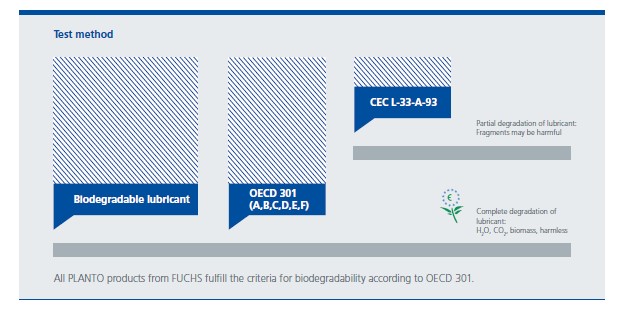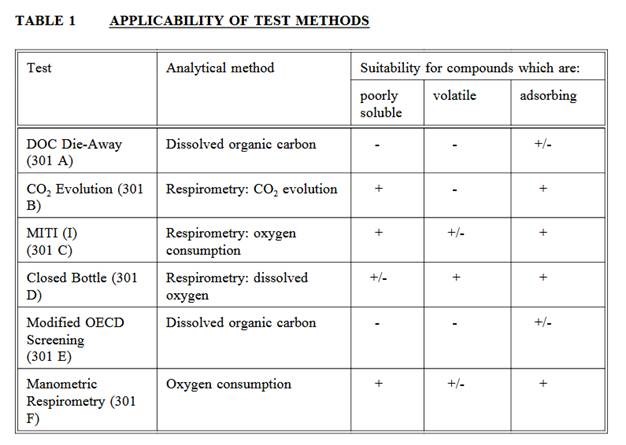
The objectives of the European Ecolabel (EEL)
The objectives of the European Ecolabel (EEL)
The EU Ecolabel according to 2011/381 / EU has been created with the following specific objectives:
- Definition of standardized technical and ecological quality standards for "biolubricants"
- Reduction of water and soil pollution
- Reduction of CO2 emissions
The "Marguerite" label facilitates the recognition of the high quality of FUCHS biodegradable lubricants.
European Ecolabel - Lubricant requirements according to 2011/381 / EU
• Biodegradable (according to OECD 301> 60%)
• Aquatic toxicity (OECD 201, 202 and 203)
• Halogenated compounds and unused nitrite compounds
• Unused organometallic compounds
• Proportion of renewable raw materials> 50% for oils (> 45% for fats)
• No danger to the environment or human health
• No relevant risk statement (R-phrases)
• Requirements for rapidly biodegradable hydraulic oils in accordance with DIN ISO 15380
• Technical performance of gear oils according to DIN 51517-3
• Technical performance of chainsaw oils according to KWF test requirements

What does "biodegradable" mean?
There is no single definition of the term "biodegradable". The process of biological decomposition usually takes place in several stages. In the first stage of the partial biological degradation, fragments of the initial material are formed, which can further harm the environment. It is only when the initial material has completely degraded to H2O that CO2 and biomass are considered fully biodegradable lubricants. Unlike CEC L-33-A-93, the OECD 301 test analyzes the complete biodegradability of lubricants.
Biodegradability according to CEC L-33-A-93 is no longer the benchmark for rapidly biodegradable lubricants on the market today because it does not take into account all the parameters. Although the CEC L-33-A-93 standard of 1993 was updated with CEC L-103-A-12 in 2012, the ultimate biodegradability tests according to OECD guideline 301 are generally authoritative today.

The six test methods according to OECD 301
The OECD Guideline 301 is divided into six different test methods: A, B, C, D, E and F. A fluid is designated biodegradable when the dissolved organic carbon (DOC) has decreased by at least 70% in the six test methods. Within 28 days the theoretical oxygen demand (THO) and the theoretical production of carbon dioxide (ThCO2) are at least 60%. These requirements for the biodegradability of lubricants also apply to the EU Ecolabel. Test methods B, C and F apply to water-insoluble products such as oils or greases and are therefore authoritative for FUCHS lubricants. Water-soluble products such as RENOLIN PG 46 hydraulic oil are tested according to OECD 301C.
1. Easy Biodegradability OECD 301 A: DOC Depletion Test
Arbitrary classification of chemicals that have responded positively to some specific "screening" tests for ultimate biodegradability; because of the rigor of these tests, it is assumed that such compounds will degrade rapidly and completely in the aquatic environment under aerobic conditions.
COD: dissolved organic carbon. It is organic carbon present in a solution or passing through a 0.45 micron porosity filter or remaining in the supernatant after 15 min centrifugation at about 4000 g (40,000 ms-2) .
A measured volume of seeded mineral medium, containing a known concentration of test substance (10 to 40 mg / L DOC) as the sole nominal source of organic carbon, is aerated in the dark or under diffuse light at 22 ± 2 ° C. The degradation is monitored by analyzing the DOC at frequent time intervals for a period of 28 days. The biodegradation rate is calculated by expressing the disappeared DOC concentration (corrected for the value obtained in the inoculum-containing control) as a percentage of the initial concentration. Primary biodegradation can also be calculated from the chemical analysis of the test substance at the beginning and end of the incubation.
Easy Biodegradability OECD 301 B: CO2 evolution test (modified Sturm test)
A measured volume of seeded mineral medium, containing a known concentration of test substance (10 to 20 mg / L DOC or TOC) as the sole nominal source of organic carbon, is aerated in the dark or under diffuse light, one pass of carbon dioxide-free air under controlled flow. The degradation is followed by the analysis of the carbon dioxide produced during a period of 28 days. The CO2 is trapped with barium or sodium hydroxide and then assayed by titration of excess hydroxide or as inorganic carbon. The amount of carbon dioxide produced by the test substance (corrected for the value obtained for the control containing the inoculum) is expressed as a percentage of CO2Th (theoretical). The rate of biodegradation can also be calculated from additional DOC analysis at the beginning and end of incubation.
Easy Biodegradability OECD 301 F: Manometric Respirometry Test
A measured volume of seeded mineral medium, containing a known concentration of test substance (100 mg / L of test substance, giving a DThO of at least 50 to 100 mg / L) as the sole nominal source of organic carbon, is stirred in a closed vial at a constant temperature (± 1 ° C maximum) for a maximum of 28 days. Oxygen consumption is determined either by measuring the amount of oxygen (produced by electrolysis) required to maintain a constant gas volume in the respirometer vial, or based on changes in volume or pressure (or a combination of two) in the device. The carbon dioxide that is released is absorbed by a potassium hydroxide solution or other suitable absorbent. The amount of oxygen consumed by the microbial population during the biodegradation of the test substance (corrected for the amount of oxygen consumed by the control containing the inoculum, conducted in parallel) is expressed as a percentage of the DThO or, less satisfying, COD. Optional primary biodegradation can also be calculated from additional specific chemical analyzes performed at the beginning and end of the incubation, as well as ultimate biodegradation by DOC analysis.
Aquatic toxicity of lubricants
The lubricant must meet the requirements defined for the EEL with regard to its main components or the requirements for each lubricant component with a concentration greater than 0.10% by weight.
The aquatic toxicity should not be determined if the classification of the base oil or additive is already defined in the classification list of the lubricant, if a valid declaration of conformity can be submitted, if the substance is so large that it can not penetrate any biological membrane (molecular weight> 800 g / mol, diameter of the molecule> 1.5 nm), if the molecular weight fraction of a polymer is less than 1000 g / mol and less than 1% or because of the low solubility of the substance in water (<10 μg / l).
The complete formula or that of each compound must be tested.
The OECD also defines three different test methods for the analysis of aquatic toxicity of lubricants: OECD 201, 202 and 203.
The acute aquatic toxicity concentration must be at least 100 mg / l for hydraulic fluids and gear oils for:
• algae (OECD 201),
• Daphnids (OECD 202) and
• fish (OECD 203)
For all other lubricants, the concentration must be at least 1000 mg / l according to the EEL. The EC50 value should be checked after 72 hours for algae or after 48 hours for daphnids, and the LC50 value after 96 hours for fish.
Advantages when using synthetic esters
- Biodegradable / minimum toxicity
- Reduction of CO2
- Fuel saving / increased efficiency
- Long service life of lubricant
- Outstanding lubrication
- Very low coefficient of friction
- High performance
- Good oxidation and aging properties
- Partially excellent low-temperature properties
- Good viscosity-temperature properties (VI 120-180)
- High solubility
- Miscible with many base fluids such as mineral oil, HEPR, HEPG